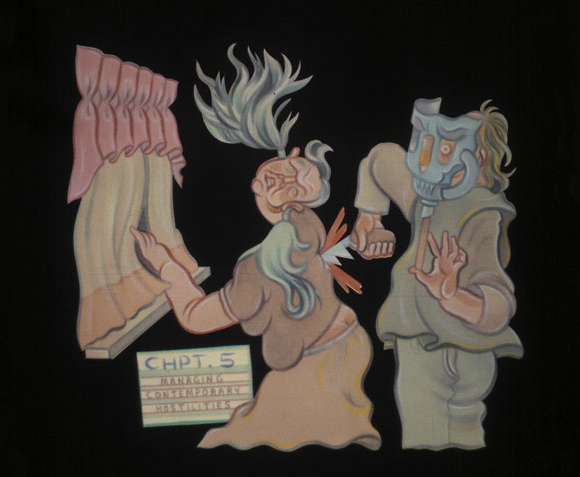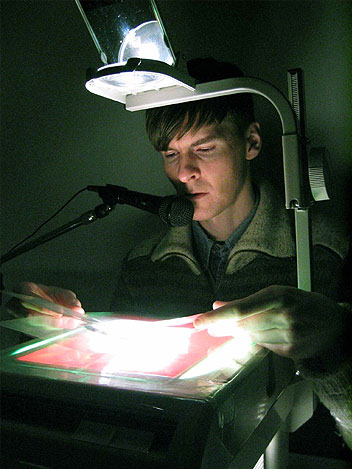Daniel Barrow – “Every Time I See Your Picture I Cry” @ City Arts Fest 2011

DANIEL BARROW
City Arts Fest
Seattle, Wa
0ct. 22, 2011
Possibly one of the most unique additions to Seattle’s City Arts Festival, visual artist Daniel Barrow performed his Sobey award-winning “Every Time I See Your Picture I Cry” at FRED Wildlife Lounge on Oct. 22. Having seen Barrow’s performance for the first time a couple of years ago in Milwaukee, I jumped at the chance to witness it again. Without experiencing his work for yourself, it might sound odd to hear that it possesses a cinematic quality, but I definitely think that’s an apt way to describe it. The performer manipulates lush, darkly comic illustrations manually via a simple overhead projector, sliding the transparencies back and forth, while narrating a tale of alienation and violence in the life of a failed art student. The visuals are set to an original score of chiming, Pet Sounds –like instrumentals composed by Amy Linton (The Aisler Set), which provides a stunning backdrop to Barrow’s sad, matter-of-fact intonation, and serves as a cheery counterpoint to the often-grisly scenarios that his characters encounter. The result is a multi-sensory psychedelic experience; cinematic, but unlike anything that conventional cinema could conjure.
Divided into ten chapters, the story revolves around an art student-turned-garbageman who reclaims his childhood nickname of “Helen Keller” (so named because of a chronic eye infection problem). Barrow assumes the voice of Keller, narrating the story from his perspective. The garbageman relates the details of his chronic eye infections, dysfunctional home life, and failure to develop as an artist with clinical detachment. In an attempt to express himself artistically, the character creates his own phone book of the city, person-by-person; each profile complete with a hand-traced portrait and biography. Part of this effort involves combing through the trash of his subjects, whose sad detritus gently rotates in constellations of discarded diary entries, used tampons, and food wrappers.

The trash collector’s antagonist is a serial killer who escapes from prison, stalks him, and murders the people in the phone book one by one. It is implied that the killer is a figure from the garbageman’s childhood; a neglected outcast nicknamed “Bag Lady.” Much time is spent exploring the relationship between Helen Keller and Bag Lady, the latter of which is described as having spent “thirty days in an incubator, and thirty years paying for it.” They are effective foils; the garbageman an erudite, dispassionate artist, and the serial killer the embodiment of impending, senseless, unthinking violence. [The serial killer does attempt to communicate at one point by using his victim’s blood to paint “EVERYTHING IS NOT OKAY. THE WORLD IS OVERPOPULATED. SOMETIMES POLITICIANS LIE” on the walls – sentiments that fit into our current political dialogue almost as well as they fit into a murder scene.] Eventually the garbageman himself falls victim to the murderer, coming to an especially gruesome end. Yet, even in the afterlife, Keller retains the same evenhanded tone, describing only mild disappointment at his demise.
Considering the poignant contrast of Barrow’s vibrant, sensory-rich performance with its musings on the sensory deprivation (as experienced by the real-life Helen Keller), the relationship between the visual and narrative elements of Every Time I See Your Picture I Cry is thrown into sharper focus. From the beginning, the infamous deaf/blind namesake of Helen Keller looms large over the performance. This is both literal, as well as figuratively true, with her portrait and biography serving as an introduction. Quotes from her journals pepper the narrative as well, reinforcing the characters’ alienation from the world around them. Indeed, the garbage man himself is -aside from his nickname- otherwise unnamed. The overall structure of Every Time I See Your Picture I Cry is deliberately dense and multifaceted, mirroring the layers of beautiful illustrations that Daniel Barrow projects. It’s an elegant relationship and one that warrants several viewings.
While the story is strangely abstract and the animation has a simple homemade quality, the overall effect is quite stunning. Quick movements, such as a character bowing or stabbing another, are particularly striking, considering that they’re the result of merely sliding transparencies around an overhead projector. There is a sense that Barrow is, in addition to an illustrator and storyteller, an illusionist plying his sleight-of-hand tricks to a room full of rubes. Daniel’s inventive use of the overhead has a distinct charm, derived from the contrast between antiquated technology and a dense, highly discursive storyline.

At its core, Every Time I See Your Picture I Cry is an exploration of what it means to tell a story. Daniel Barrow‘s ability to bring simple elements of sound and color together in a single space creates -as I’ve said- a cinematic experience. It seems unfair, though, to describe his work in terms of the technology he deliberately eschews. If anything, the illustrator’s work seems pre-cinematic, in that it relies on simpler techniques to deliver an experience that cinema eventually monopolized. For anyone who has lamented the way that digitized screen time exerts itself over our lives, the illustrator/performer’s low-tech masterpiece will no doubt strike a chord.
After seeing it a second time, I definitely wished that there was a way to revisit the experience of the performance, after the fact, as well. Unfortunately, it’s nearly impossible to find a representative example of Barrow‘s work online, besides a few still images and short clips of other works. Having attempted (and inevitably failed) to explain to friends what exactly Daniel‘s show consists of, I can say that it’s definitely something that needs to be experienced live. Although he has toured with this performance for several years, Barrow said that this was his first time in Seattle. I was surprised by this, given that he is from Winnipeg and tours widely in Canada. In any case, here’s to hoping we see more of his work returning to the area in the near future.
